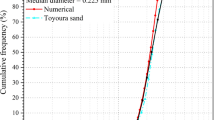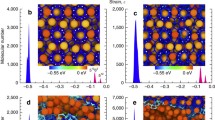Abstract
Fundamental mechanics of gas hydrates is of importance to evaluating geomechanical and geotechnical properties of gas hydrate deposits, but it remains largely unexplored yet due to insufficient direct experimental techniques and high-quality of gas hydrate samples. Here, classic molecular dynamic (MD) simulations are used to study the fracture mechanics of three main methane clathrate hydrates of sI, sII and sH types. The results show that the mechanical properties of those three methane clathrate hydrates are intrinsically different and are degraded by the presence of nanocracks. They show brittle facture and different fracture toughness. In terms of energy release rate, they are ranked as \(\text {sH}\!\!>\!\!\text {sI}>\!\!\text {sII}\). Moreover, the three methane clathrate hydrates with nanocracks can be explained by a modified Griffith criterion. Moreover, it is intriguingly identified tip amorphization during the crack propagation process of the three methane clathrate hydrates, and sH methane clathrate hydrate with specific nanocrack exhibits slower crack propagation than other two methane clathrate hydrates.






Similar content being viewed by others
References
Atig, D., Broseta, D., Pereira, J.M., et al.: Contactless probing of polycrystalline methane hydrate at pore scale suggests weaker tensile properties than thought. Nat. Commun. 11, 1–9 (2020)
Wu, Y., Hyodo, M., Cui, J.: On the critical state characteristics of methane hydrate-bearing sediments. Mar. Pet. Geol. 116, 104342 (2020)
Fu, W., Wang, Z., Zhang, J., et al.: Investigation of rheological properties of methane hydrate slurry with carboxmethylcellulose. J. Pet. Sci. Eng. 184, 106504 (2020)
Peng, Z., Gomberg, J.: An integrated perspective of the continuum between earthquakes and slow-slip phenomena. Nat. Geosci. 3, 599–607 (2010)
Max, M.D., Lowrie, A.: Oceanic methane hydrates: a frontier gas resource. J. Pet. Geol. 19, 41–56 (1996)
Makogon, Y.F., Holditch, S.A., Makogon, T.Y.: Natural gas-hydrates–a potential energy source for the 21st Century. J. Pet. Sci. Eng. 56, 14–31 (2007)
Kvenvolden, K.A.: Gas hydrates–geological perspective and global change. Rev. Geophys. 31, 173–187 (1993)
Max, M.D., Clifford, S.M.: The state, potential distribution, and biological implications of methane in the Martian crust. J. Geophys. Res-Planet. 105, 4165–4171 (2000)
Buffett, B., Archer, D.: Global inventory of methane clathrate: sensitivity to changes in the deep ocean. Earth. Planet. Sci. Lett. 227, 185–199 (2004)
Sveinsson, H.A., Malthe-Sørenssen, A.: Molecular-scale thermally activated fractures in methane hydrates: a molecular dynamics study. Phys. Chem. Chem. Phys. 21, 13539–13544 (2019)
Zhu, C., Jiao, X., Cheng, S., et al.: Visualising fluid migration due to hydrate dissociation: implications for submarine slides. Environ. Geotech. 0, 1–9 (2020)
Zhang, X., Luo, D., Lu, X., et al.: Mechanical properties of gas hydrate-bearing sediments during hydrate dissociation. Acta Mech. Sin. 34, 266–274 (2018)
Kvenvolden, K.A.: Potential effects of gas hydrate on human welfare. Proc. Natl. Acad. Sci. USA 96, 3420–3426 (1999)
Maslin, M., Owen, M., Betts, R., et al.: Gas hydrates: past and future geohazard? Proc. R. Soc. A 368, 2369–2393 (2010)
Ning, F., Yu, Y., Kjelstrup, S., et al.: Mechanical properties of clathrate hydrates: status and perspectives. Energy Environ. Sci. 5, 6779–6795 (2012)
Xu, W., Lowell, R.P., Peltzer, E.T.: Effect of seafloor temperature and pressure variations on methane flux from a gas hydrate layer: comparison between current and late Paleocene climate conditions. J. Geophys. Res. 106, 26413–26423 (2001)
Lambeck, K., Esat, T.M., Potter, E.K.: Links between climate and sea levels for the past three million years. Nature 419, 199–206 (2002)
Becke, A.D.: Density-functional exchange-energy approximation with correct asymptotic behavior. Phys. Rev. A 38, 3098 (1988)
Stern, L.A., Kirby, S.H., Durham, W.B.: Peculiarities of methane clathrate hydrate formation and solid-state deformation, including possible superheating of water ice. Science 273, 1843–1848 (1996)
Stern, L.A., Kirby, S.H., Durham, W.B.: Polycrystalline methane hydrate: synthesis from superheated ice, and low-temperature mechanical properties. Energy Fuel 12, 201–211 (1998)
Miranda, C.R., Matsuoka, T.: First-principles study on mechanical properties of CH4 hydrate. (2008)
Cao, P., Wu, J., Zhang, Z., et al.: Mechanical properties of methane hydrate: intrinsic differences from ice. J. Phys. Chem. C 122, 29081–29093 (2018)
Daghash, S.M., Servio, P., Rey, A.D.: Elastic properties and anisotropic behavior of structure-H (sH) gas hydrate from first principles. Chem. Eng. Sci. 227, 115948 (2020)
Li, Q., Liu, C.: Molecular dynamics simulation of heat transfer with effects of fluid–Clattice interactions. Int. J. Heat Mass Transf. 55, 8088–8092 (2012)
Zhan, H., Gu, Y.: A fundamental numerical and theoretical study for the vibrational properties of nanowires. J. Appl. Phys. 111, 124303 (2012)
Peng, T., Li, Q., Liu, C.: Accelerated aqueous nano-film rupture and evaporation induced by electric field: a molecular dynamics approach. Int. J. Heat Mass Transf. 94, 39–48 (2016)
Hu, J., Liu, C., Li, Q., et al.: Molecular simulation of thermal energy storage of mixed CO2/IRMOF-1 nanoparticle nanofluid. Int. J. Heat Mass Transf. 125, 1345–1348 (2018)
Sloan, E.D.: Fundamental principles and applications of natural gas hydrates. Nature 426, 353–359 (2003)
Sloan, E.D.: Gas hydrates: review of physical/chemical properties. Energy Fuel 12, 191–196 (1998)
Kirchner, M.T., Boese, R., Billups, W.E., et al.: Gas hydrate single-crystal structure analyses. J. Am. Chem. Soc. 126, 9407–9412 (2004)
Pizzagalli, L., Godet, J., Guénolé, J., et al.: A new parametrization of the Stillinger–CWeber potential for an improved description of defects and plasticity of silicon. J. Phys. 25, 055801 (2013)
Molinero, V., Moore, E.B.: Water modeled as an intermediate element between carbon and silicon. J. Phys. Chem. B 113, 4008–4016 (2009)
Jacobson, L.C., Molinero, V.: A Methane–water model for coarse-grained simulations of solutions and clathrate hydrates. J. Phys. Chem. B 114, 7302–7311 (2010)
Wu, J., Ning, F., Trinh, T.T., et al.: Mechanical instability of monocrystalline and polycrystalline methane hydrates. Nat. Commun. 6, 1–10 (2015)
Cao, P., Ning, F., Wu, J., et al.: Mechanical response of nanocrystalline ice-contained methane hydrates: key role of water ice. ACS Appl. Mater. Interfaces 12, 14016–14028 (2020)
Plimpton, S.: Fast parallel algorithms for short-range molecular dynamics. J. Comput. Phys. 117, 1–19 (1995)
Stukowski, A.: Visualization and analysis of atomistic simulation data with OVITO—the Open Visualization Tool. Modell. Simul. Mater. Sci. Eng. 18, 015012 (2009)
Elfakhakhre, N., Long, N.N., Eshkuvatov, Z.: Numerical solutions for cracks in an elastic half-plane. Acta Mech. Sin. 35, 212–227 (2019)
Paris, P.C.: A brief history of the crack tip stress intensity factor and its application. Meccanica 49, 759–764 (2014)
Benham, P.P., Crawford, R.J., Armstrong, C.G.: Mechanics of Engineering Materials. Longman, Harlow (1996)
Yin, H., Qi, H.J., Fan, F., et al.: Griffith criterion for brittle fracture in graphene. Nano Lett. 15, 1918–1924 (2015)
Irwin, G.R.: Analysis of stresses and strains near the end of a crack traversing a plate. J. Appl. Mech. 24, 361–364 (1997)
Zhao, Y., Peng, X., Huang, C., et al.: Notch effects on deformation of crystalline and amorphous AlN–CA nanoscale study. Ceram. Int. 45, 907–917 (2019)
Ida, Y.: Cohesive force across the tip of a longitudina-shear crack and Griffith’s specific surface energy. J. Geophys. Res. 77, 3796–3805 (1972)
Wang, B., Yu, Y., Lee, Y.J., et al.: Intrinsic nano-ductility of glasses: the critical role of composition. Front. Mater. 2, 11 (2015)
Yu, J., Wang, M., Lin, S.: Probing the soft and nanoductile mechanical nature of single and polycrystalline organic–Cinorganic hybrid perovskites for flexible functional devices. Acs Nano. 10, 11044–11057 (2016)
Liu, N., Hong, J., Pidaparti, R., et al.: Fracture patterns and the energy release rate of phosphorene. Nanoscale 8, 5728–5736 (2016)
Lu, X., Hou, Y., Tie, Y., et al.: Crack nucleation and propagation simulation in brittle two-phase perforated/particulate composites by a phase field model. Acta Mech. Sin. 36, 493–512 (2020)
Anderson, T.L.: Fracture Mechanics: Fundamentals and Applications. CRC Press, Boca Raton (2017)
Wu, J., Gong, H., Zhang, Z., et al.: Topology and polarity of dislocation cores dictate the mechanical strength of monolayer MoS2. Appl. Mater. Today 15, 34–42 (2019)
Acknowledgements
This work was supported by the National Natural Science Foundation of China (Grants 11772278, 11904300 and 12002350) and the Jiangxi Provincial Outstanding Young Talents Program (Grant 20192BCBL23029). We thank Y. Yu and Z. Xu who are from Information and Network Center of Xiamen University for the technical help of the high-performance computer.
Author information
Authors and Affiliations
Corresponding authors
Additional information
Executive Editor: Yuejie Wei.
Supplementary Information
Below is the link to the electronic supplementary material.
Rights and permissions
About this article
Cite this article
Liu, J., Xu, K., Yang, L. et al. Fracture mechanics of methane clathrate hydrates. Acta Mech. Sin. 37, 1387–1394 (2021). https://doi.org/10.1007/s10409-021-01105-y
Received:
Accepted:
Published:
Issue Date:
DOI: https://doi.org/10.1007/s10409-021-01105-y




